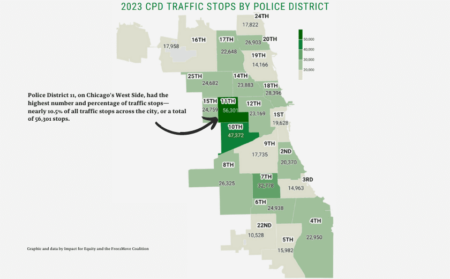A federal jury Thursday awarded $27 million to a man who spent more than two decades in prison after being wrongfully convicted in a double-fatal arson as a teenager, finding that Chicago police coerced his confession, fabricated evidence, and violated his civil rights.
As the verdict was announced in U.S. District Judge Edmond Chang’s courtroom, the plaintiff, Adam Gray, bowed his head and leaned into his attorney, Jon Loevy, who hugged his shoulders.
Afterward, Loevy told reporters that Gray’s life has been “damaged immeasurably” by the ordeal, but that he’s trying to get his life back on track.
“Adam was arrested before breakfast, they had the case closed before noon, and were home early for dinner,” Loevy said in the lobby of the Dirksen U.S. Courthouse. “It took 24 years for the system to sort it out.”
Gray issued a short statement, saying “These dirty cops need to be stopped.”
“It’s out of control,” he said. “Break down that blue wall of silence.”
Gray then left the courthouse while the news conference was still going and walked to the nearby hotel where he’s staying.
The $27 million in compensatory damages awarded by the jury appears to be the highest award ever given to a single plaintiff in a wrongful conviction case here, edging out the $25.2 million handed to Eddie Bolden in 2021 for his wrongful murder conviction.
The jury did find in favor of the one surviving police detective named in the lawsuit, Daniel McInerney, awarding no punitive damages.
A spokesperson for the city’s Law Department had no immediate comment.
Gray, who was arrested at just 14 and had been sentenced to mandatory life without parole, was released from prison in May 2017 after Cook County prosecutors decided that advancements in fire science raised too many questions about his conviction for setting a fire in 1993 that killed two people on Chicago’s Southwest Side.
His 54-page lawsuit filed five years ago named the city of Chicago as well as a host of former Chicago police detectives, a youth officer, a retired Cook County assistant state’s attorney and a former fire marshal.
The suit alleged detectives “concocted and coerced” a false confession from Gray after hours of illegal interrogation while refusing to allow him to see his mother and brother, who were at the station trying to talk to him. Instead, detectives told Gray that his mother had told them “she did not care about him and refused to come to the police station altogether,” the suit alleged.
Afternoon Briefing
Daily
Chicago Tribune editors’ top story picks, delivered to your inbox each afternoon.
Police and prosecutors had alleged that at the time of the fire, Gray was angry with a girl who lived in a two-flat in the 4100 block of South Albany Avenue because she had rejected him. The eighth-grader ignited an accelerant he poured on the enclosed back porch on the second floor and the stairs, according to investigators at the time. While the girl and her parents escaped, the second-floor tenants, Peter McGuiness, 54, and his sister, Margaret Mesa, 74, died.
At Gray’s trial, prosecutors focused on evidence that the fire had been intentionally set and the confession from Gray. Two fire investigators said they found alligator charring and deep burn patterns at the scene and concluded they were evidence of a hot fire set with an accelerant. A milk jug found in the alley behind the home contained what police believed was an accelerant. A gas station clerk said Gray bought gas shortly before the fire.
In a statement to police, Gray admitted to buying gasoline to set the fire, but he later denied the admissions, saying he confessed only because of pressure from the officers questioning him. Gray’s attorney said he had been questioned for seven hours and couldn’t endure the pressure.
The lawsuit alleges police at some point in the interrogation had “obtained” an empty milk jug and concocted the story about Gray filling it with gas. Tests revealed there was no gasoline or gas residue in or on the jug, the lawsuit states.
Gray’s path to having the charges against him dismissed was a long one. While advances in fire science date to the early 1990s, around the time Gray was convicted, it took investigators years to embrace those changes. Instead they continued to investigate fires using methods they learned from veteran colleagues or gathered from their own experience, even though the practices weren’t rooted in science.
Today, those new rules are widely accepted by fire investigators, resulting in prosecutors and defense attorneys around the country reopening old cases to determine whether the fires at the center of them were, in fact, arsons. Many convictions have been set aside.
jmeisner@chicagotribune.com







